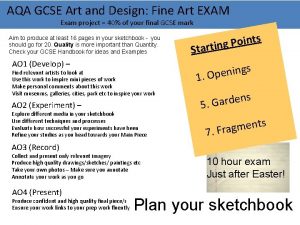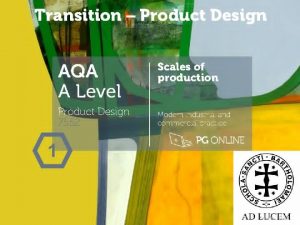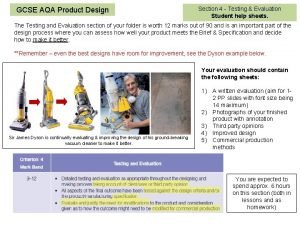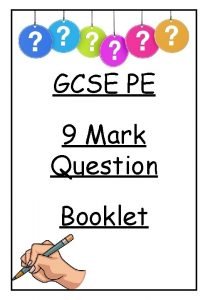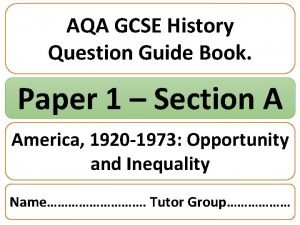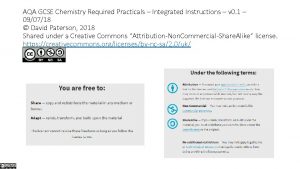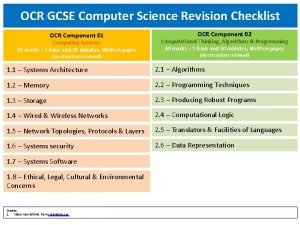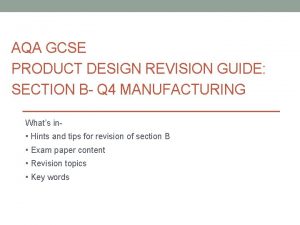GCSE AQA Product Design Section 4 Testing Evaluation








- Slides: 8

GCSE AQA Product Design Section 4 - Testing & Evaluation Student help sheets. The Testing and Evaluation section of your folder is worth 12 marks out of 90 and is an important part of the design process where you can assess how well your product meets the Brief & Specification and decide how to make it better. **Remember – even the best designs have room for improvement, see the Dyson example below. Your evaluation should contain the following sheets: Sir James Dyson is continually evaluating & improving the design of his ground-breaking vacuum cleaner to make it better. 1) A written evaluation (aim for 12 PP slides with font size being 14 maximum) 2) Photographs of your finished product with annotation 3) Third party opinions 4) Improved design 5) Commercial production methods You are expected to spend approx. 6 hours on this section (both in lessons and as homework)

Your evaluation should contain the following sheets: 1) A written evaluation (aim for 1 -2 PP slides with font size being 14 maximum) 2) Photographs of your finished product with annotation 3) Third party opinions 4) Improved design 5) Commercial production methods There are 8 sections to your evaluation they all need to be covered within your written evaluation. Your writing should be no larger than font size 14. You can also include images within your write up. Those 8 sections are: 1) 2) 3) 4) 5) 6) 7) 8) Specification Testing Modifications How well did you work? Improvements Commercial production Green issues Overall Review GCSE AQA Product Design Section 4 - Testing & Evaluation Writing about each section in detail answering the questions included within this booklet will ensure you gain top level grades within criteria 4.

1) Specification Once the question has been answered tick/cross the box. Question – How has your lamp met with your specification? The points in the specification you wrote previously in the project need to be reviewed and checked against the final outcome. Then answer (in a paragraph): I have met my specification because…. I have not met the specification because… q Why did you change it? q How does this make the light better? Make sure you cover these points and use the headings (in bold) Target Market q Is it the same as your target market in the specification? q If so how is it? q If not, why have you changed it? q Who would buy this lamp and why? q Size q Is it the same size as you quoted in your specification? q Do the spacers march the size of the lamp and why? q Would you see this lamp in the home of your chosen target market? GCSE AQA Product Design Function q Does it meet your specification? q How well does it work? Does it let out enough light? If not, why? q What sort of lighting type is it and why? q Has the function of the lamp been affected by the design? Section 4 - Testing & Evaluation Aesthetics q Does the product look as you wrote in your early specification? q Would you buy this lamp? If so, why? If not, why?

1) Specification Environment q Is it the same as your specification, if so why is it suitable for that room? q Could it be used in a different room? If so why? Once the question has been answered tick/cross the box. Materials & Manufacture q Have you used the same materials as you stated in your specification? q If not, why? Why did you make these changes? q In your specification we didn’t explain how the base would be made as we had not modelled it, so why did you make your base this way? q How did you make sure that your base lined up with your laser cut acrylic shape? q What problems did you have with the base and why? q What materials and finishes did you use of your lamps base and why? q Why did you laser cut your design? Quality Assurance (laser makes sure that all the pieces are the same size, shape, cut to the same quality etc) GCSE AQA Product Design Cost q How much did you say in your specification your lamp would be sold for? q Would you still sell it for that price and why? Section 4 - Testing & Evaluation Safety q Is your lamp safe to use? q How you tested it? q How would you promote to the IKEA customer that your lamp is safe?

2) Testing Once the question has been answered tick/cross the box. To complete this section answer all of the questions in full sentences. q How have you tested your light and what did you find out? q Did you model the light to see how it looked at a complete design? q Did you assemble the light to see if it worked at what points and why? q When you tested the light what did people think? q Have you tested in the lamp in a suitable room (room illustration) and did you think it was suitable for that room? If not why not? 3) Modifications q What changes did you make during this project and why? q How did you change your idea from your final design? 4) q q q How well did you work? What sections did you struggle with and how did you improve that? What section did you do well on? Do you think you managed your time well during the coursework? If not, how could you improve? Have you done everything that you wanted to do? If you had longer or could complete the project again what would you change? GCSE AQA Product Design q How did these make your lamp better? Section 4 - Testing & Evaluation Did you change the following, if so explain why: q The acrylic shape q The colour of the acrylic q The size of the lamp q The base design q The positions of the support poles q The number of layers

5) Improvements Once the question has been answered tick/cross the box. q What changes would you make to your lamp and supporting packaging to make it more suitable to your target market? q How would these changes make it better? 6) Commercial Production Methods Commercial production means what changes would have to be made to make this suitable for it to be manufactured in industry. There are three different types of production One off – A prototype (your lamp)/a one off piece Mass – This is to produce 10, 000 s of the same product. For this you have to use CAM to make sure they are all the same. Your base was hand made (one off production) and it would need to be changed to use a CAM/CAM process to make it suitable for Mass Production. Possible production processes could be: -Injection Moulding -Laser cut -CNC Router GCSE AQA Product Design If my lamp was to be mass produced I would have to change my base because…. Section 4 - Testing & Evaluation Batch – Making a small quantity of the same product. You will need to have templates/jigs to make sure they are all the same. You completed a batch of the acrylic shapes using CAD [Corel draw] and CAM [laser cutter]. By using CAM you were able to make them all the same.

7) Green Issues q How environmentally friendly is your lamp, box and its packaging? q What alternatives could you use? q What symbols do you need to add to the lamps packaging to promote green issues? Once the question has been answered tick/cross the box. TIPS Plywood – Can be recycled but it would be better to use it from a sustainable source (a forest where trees are cut and replanted in there place) Acrylic – can be recycled but it is very hard and is not commonly done. Cardboard – Can be recycled as long as it can be separated from other materials. 8) Overall Review GCSE AQA Product Design Section 4 - Testing & Evaluation q What is your overall view of the lamp and its packaging that you have designed and manufactured? q Would you personally buy the lamp? If so, why? If not, why? q Do you think IKEA would sell it?

Finished Product Include as many photos of your finished product as you can to show clearly the skills and quality of finish you have achieved. Photographs showing you assembling your lamp (step by step) with annotation will clearly shows this as well as your manufacturing log. This can be either a hand drawing, model or 3 D model using Corel draw, Google sketch up or even Solid works. State on the drawing what the improvements/ alterations are and why you have made them. GCSE AQA Product Design Using the responses from your evaluation and testing draw an improved design. Section 4 - Testing & Evaluation Improved Design
